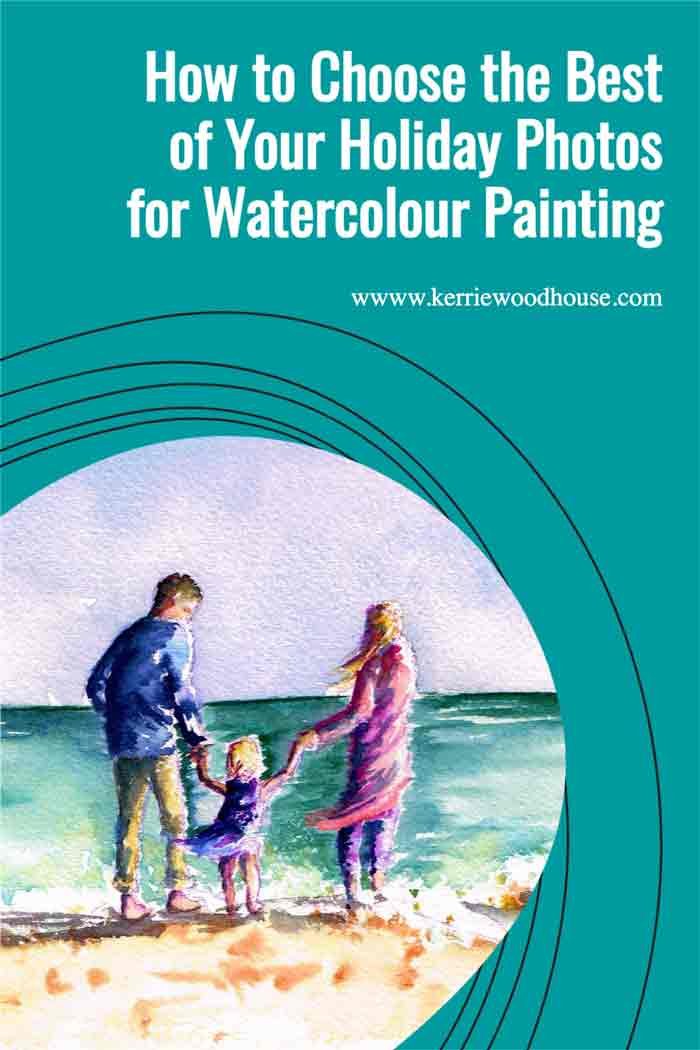How to Choose the Best of Your Holiday Photos for Watercolour Painting
Capture the memories of your holiday and turn them into delightful works of art with watercolour painting. The key to success is choosing the right photo to paint.
Let me guide you through the process of selecting the best vacation photos for watercolour painting. From considering composition and lighting to analysing colour and subject matter, I want to share my tips and tricks to help you make the perfect choice for your next watercolour painting.
We painters are visual folk. We think and feel in pictures.
One of my favourite things to do is to relive happy memories with paint. Actually, just revisiting my photos app on my phone is a happy thing indeed, but even better is creating a watercolour painting from one of those photos.
(Actually I wrote a whole separate article about savouring a moment in paint - click here if you want to read more about that.)
But not all photos are created equal when it comes to choosing a good reference to paint from. Here are my top tips for choosing a photo that is going to give you the best start towards creating a rewarding watercolour painting.
Choose Photos With People in Them…
Often the happiest photos include our loved ones, who wouldn’t want to try to paint them?
Including figures in our painting can be a scary prospect I know, but you can make a few careful choices to make your job a bit easier.
Adopt the approach of simplicity and reduced detail for greatest success. That means you don’t want to add every eyelash and finger nail. And definitely don’t worry about trying to paint individual teeth in a smile! You may want to choose a photo with a closed lips smile to make your life easier.
Of course if the whole idea of including a figure puts you off painting altogether, then of course - just paint the landscape scene. It’s always better to paint than NOT to paint!
And if you like the idea of painting figures but would enjoy a little step by step help with that, this bundle of Watercolour Tutorials is for you.
Paint people with confidence
These 4 step by step watercolour tutorials will have you including figures in your paintings with ease.
(Yes, even if you think you can’t draw)
But Remember that You Are Not a Camera
First of all, I would always suggest aiming for a loose, impressionistic capture of the moment - not replicating the photo. Don’t forget - you already have the photo - so why make an exact copy?
Choose a photo that reduces that temptation.
I like painting figures from behind. That means you won’t be worrying about how to add the face. I also rather enjoy the way a painting like this feels like you are witnessing a private little moment - something of a privileged view.
It makes the viewer more of a fly on the wall, so to speak since the subject isn’t making any eye contact with the viewer.
This tutorial is part of the Watercolour Tutorial Figures Bundle - Click Here to Learn More
Choosing a photo that has a figure in the distance will also be very helpful in reducing the amount of detail. All you need to do is capture the the overall shapes and simple gestures of the figures.
You will probably be surprised at how recognisable the figures are to you even in that more abstracted form.
Background and Composition
The background of the holiday photo might be the very reason you wanted to create a painting in the first place. We often choose to take our vacations in the locations we find the most beautiful. So perhaps you are choosing a landscape with no figures. In this case the background is the painting.
But if you chose a photo with a person in it, it’s best to make sure that the scene is not too chaotic. The figure (or figures) will automatically be the focal point of your painting. We don’t want the background to be competing with them.
This tutorial is part of the Watercolour Tutorial Figures Bundle - Click Here to Learn More
A nice simple backdrop will give your figures their chance to shine.
A painting is generally more pleasing when the main focal point is not slap bang in the middle of the painting. (Bear in mind that all these composition ‘rules’ are suggestions. Use the guidelines when they are helpful but don’t feel completely constrained by them.)
A simple rule to keep in mind when it comes to composition is the rule of thirds. If you imagine dividing the photo into thirds both horizontally and vertically you end up with four hotspots where those imaginary lines would intersect. Try to choose a photo that places your figure on one of those spots.
If you choose a photo with no figure, try to make sure there is something interesting on one of those spots, a nice tree perhaps, or a building or a mountain on the horizon.
Speaking of horizons, its best to choose a photo where the horizon sits either on the top or bottom of those imaginary third lines rather than splitting the painting exactly in half.
Lighting
To avoid a flat looking painting, and achieve more of a lively three dimensional quality, it is best to choose a photo with strong lighting.
The way we can show the volume and depth of a subject is by painting the highlights and shadows. Choosing a photo that already has some nice strong lights and darks will set your painting up for success.
Photos that were taken earlier in the morning or later in the evening will usually be your best bet.
This tutorial is part of the Watercolour Tutorial Figures Bundle - Click Here to Learn More
Editing Your Photo
Reserve the right to alter the universe - how often do you get to do that? In painting it is always your prerogative.
Feel free to put things in and take things out as you see fit. We mentioned excluding a figure if you wish to earlier. Remember the same applies to anything you wish wasn’t there. An ugly lamp post perhaps, a bit of trash caught in the frame. These things you can just ignore.
Equally, you can make the sunset more colourful or add a few extra flowers to the shrubbery on a whim. How wonderful.
Want to add a pop of colour by changing the colour of someone’s clothes?
Just a flick of your magic paint wand and it is done… 🪄
This tutorial is part of the Watercolour Tutorial Figures Bundle - Click Here to Learn More
It is possible to do a fair amount of editing on your phone’s camera app. In fact I have a whole article about taking better painting reference photos with your phone camera that includes more details on editing too.
Of course you can make these edits in your mind’s eye and paint the photo the way you wish it was even if you can’t or don’t wish to edit the photo itself.
Either way, it is an important and very fun part of the creative process.
I hope this article has encouraged you to get out the holiday photo albums and capture those joyful memories in your next watercolour painting.
And if you would like to learn to paint figures in watercolour, check out this value bundle of step by step tutorials while you still can.
ENROLMENT CLOSES 28 FEBRUARY 2023
Are you on your own painting journey?
One of these might be useful…












